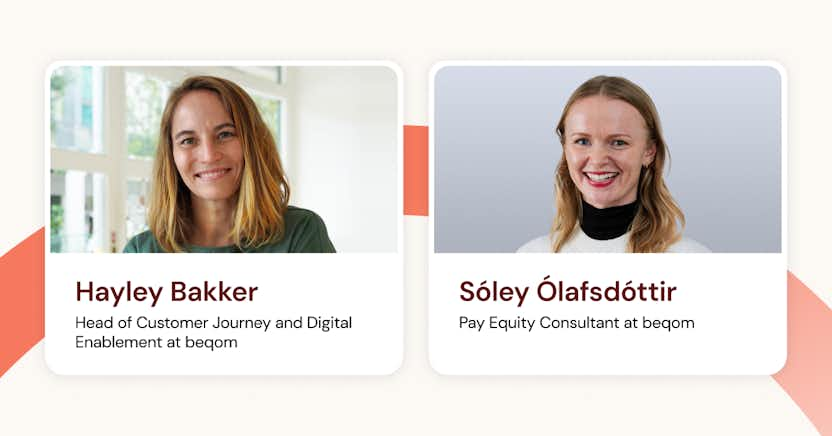10 Proven Practices for Building a Strong Corporate Culture

Learn more about the following beqom products
Building a solid company culture is paramount for long-term success. Culture drives employee behavior, shapes interactions, and influences how work gets done. It encompasses shared values, beliefs, and norms, creating a unique environment that sets an organization apart
Every organization has a culture, whether intentional or not. It’s important to nurture a positive, intentional culture. An unintentional culture can be non-productive, destructive, or even downright toxic.
A positive culture advances collaboration, open communication, and employee engagement, enhancing the company’s reputation and improving business outcomes while reducing risk. This article highlights the benefits of a well-established company culture and outlines ten culture-building approaches.
Understanding company culture
Definition and elements
Company culture is the collective and joint set of core values, norms, and practices that are fundamentals for an organization and are the components of its structure. It defines the overall identity of an organization and its internal and external image. Company culture comprises various elements that describe an organization's character and atmosphere.
The "Cultural Onion" model provides a structured way to understand these elements by breaking them down into layers:
- Values: The core beliefs and principles that underpin the culture.
- Symbols: Visual and tangible representations of the culture.
- Rituals: Regular activities and traditions that reinforce the culture.
- Heroes: Individuals who embody the culture and serve as role models.
- Practices: Daily behaviors and actions that manifest the culture.
Together, these elements create a cohesive and dynamic company culture that shapes the overall experience of working within the organization. Understanding and managing these elements can help build a positive culture that drives employee engagement and organizational success.
Assessing your current culture
Evaluating your company's existing culture is essential for understanding its strengths and areas for improvement. Methods for assessment of your company's current culture include:
- Employee Surveys: Gathering employees' perspectives on various aspects of the company culture, like values alignment, communication, leadership, and overall job satisfaction.
- Focus Groups: Providing more profound insights into specific cultural issues.
- One-on-One Interviews: Gaining a better understanding of their individual experiences and perceptions of the company culture.
- Observation: Paying attention to meetings, decisions, and employee interactions.
- Cultural Audits: Conducting a formal review of the company's policies, procedures, and practices to determine how well they align with the stated values and desired culture.
- 360-Degree Feedback: Providing a well-rounded view of an employee's behavior and how it aligns with the company culture.
- Exit Interviews: Conducting interviews with employees leaving the organization to understand their reasons for departure and gather insights into cultural issues that may have influenced their decision.
- Employee Net Promoter Score (eNPS): Using the eNPS metric to measure employees' willingness to recommend the company as an excellent workplace. Employees rate their likelihood on a scale from 0 to 10, and the scores are used to calculate an overall index.
- Document and Policy Review: Analyzing internal documents, policies, and communication materials to understand the official stance on culture and how it is communicated to employees.
- Benchmarking: Comparing your company's culture with other organizations in the same industry or with recognized best practices.
Combining these methods offers a comprehensive understanding of your current culture, facilitating the development of effective improvement strategies.
Culture-building practices
Building a high-performance culture involves intentional and strategic actions that encourage a positive, inclusive, and productive work environment. Here are some effective culture-building practices:
1. Establish shared values
Involving and engaging your people in defining and refreshing company values, makes employees more likely to embrace and embody them. Regularly revisit and reinforce values through internal communications, meetings, and performance reviews.
Apple provides a great example of successful value implementation with its clearand well-communicated set of shared values. These include Accessibility, Education, Environment, Inclusion and Diversity, Racial Equity and Justice Initiative, and Supplier Responsibility,
2. Invest in diversity, equity, inclusion, and belonging programs
Investing in diversity, equity, inclusion, and belonging (DEIB) programs and improving your company’s DEIB strategies is essential for creating a workplace that values and respects all employees. Execute inclusive hiring practices and onboarding, support Employee Resource Groups (ERGs), and create inclusive physical and digital spaces to promote diversity and inclusion and enhance understanding and empathy.
This is where implementing a dedicated compensation management software can be particularly helpful, facilitating your DEIB efforts. Adopting such a solution enables organizations to ensure pay equity and make all employees feel valued, respected, and empowered to contribute their best work. For example, the renowned global insurance company Allianz won an HR Management Prize for Global Approach to Pay Equity after implementing purpose-built pay equity software.
3. Ground your culture in mutual trust
Establishing mutual trust within an organization is paramount for a positive work environment. Hold open forums, encourage a feedback culture, and be transparent in decision-making to build trust with your team.
4. Distribute responsibility appropriately
The proper distribution of responsibility means empowering employees to take ownership of their decisions. When employees have autonomy, they feel more committed and responsible. Apply Areas of Responsibility (AORs) to effectively delineate specific accountabilities, prevent overlap, and enhance productivity. There are many task management solutions, such as Asana, Trello, and Monday, designed to streamline workflows and responsibility allocation.
5. Increase clarity to reduce silos
Connecting daily work to company goals and clearly articulating how each employee’s tasks align with the overall objectives can reduce silos. Maintain regular communication of the company’s vision, mission, and goals to ensure everyone is aligned. Goal management software and tools like objectives and key results (OKRs) and project management platforms enhance transparency and progress tracking.
One of the world’s leading telecommunications operators offers a good example of the benefits of ensuring visibility across the organization. The sales performance management solution they implemented helped them reduce excessive costs and reseller claims by 90%. As a result the company saw substantial savings and improved relations with their reseller network.
6. Build great hiring and onboarding processes
Incorporating inclusive and bias-free hiring practices and providing effective onboarding programs are essential for building great teams. Develop recruitment processes that minimize unconscious bias and promote fairness. Make sure to provide structured onboarding plans that cover job-specific training, company culture, and clear communication of expectations and goals.
Additionally, offer resources and tools such as employee handbooks, training modules, and company intranet. They can greatly enhance the onboarding experience and boost new employees' confidence and sense of belonging.
7. Promote work-life balance
By focusing on physical health initiatives, mental health support, and social well-being programs, organizations can promote a holistic approach to work-life balance. This comprehensive strategy benefits employees and positively impacts the organization by leading to higher engagement, reduced turnover, and improved performance.
Prioritize work-life balance in these areas to show your commitment to employees' well-being and foster a loyal and motivated workforce. Physical health initiatives, mental health support, and social well-being programs are vital to promoting work-life balance. Encourage employees to participate in wellness challenges, provide access to mental health resources, and organize social well-being programs to support employees' overall well-being.
8. Encourage continuous learning and development
To promote continuous upskilling and professional development, organize regular learning sessions and workshops. These cover various topics, from industry-specific skills to areas like leadership, communication, and time management.
Interactive workshops, led by internal experts or external trainers, provide practical, hands-on experiences. In addition, provide professional development opportunities, such as access to external training programs, certifications, and conferences.
9. Recognize and celebrate achievements
Employee recognition can take many forms, such as highlighting accomplishments in company meetings, newsletters, or internal communication platforms. Incentivize employees by offering tangible benefits such as bonuses, gift cards, extra vacation days, or professional development opportunities. Using workforce analytics allows you to ensure efficient and objective reward and recognition management.
In addition to recognizing professional accomplishments, celebrating personal milestones and out-of-work achievements is essential for creating an all-inclusive and supportive work environment. Acknowledge events such as birthdays, work anniversaries, weddings, or childbirth to make employees feel personally valued and connected to the organization. Simple gestures can show employees that the company cares about their well-being beyond their professional contributions.
10. Foster open communication and collaboration
Regular team-building activities, including workshops, retreats, team challenges, or informal gatherings, help foster open communication and collaboration among colleagues. Digital collaboration tools like Slack, Microsoft Teams, and Zoom facilitate real-time communication and seamless collaboration for remote and in-office team members.
Overcoming challenges and measuring success
Common challenges in building culture
Building a strong company culture can face several major challenges, including:
- Resistance to change: Employees may resist new cultural norms due to fear, comfort with the status quo, or skepticism.
- Maintaining engagement: Cultural transitions can lead to uncertainty and disengagement among employees.
- Communication barriers: Miscommunication or lack of transparency can cause confusion and mistrust.
- Aligning diverse perspectives: Different backgrounds and values can make it challenging to create a unified culture.
Providing opportunities for employees to shape and evolve the culture can enhance their commitment and sense of ownership.
Strategies for overcoming these challenges
Here are two successful strategies for overcoming resistance to change and maintaining engagement in building a strong company culture:
Leadership commitment and modeling behavior
Leadership has a crucial role in overcoming resistance to change and ensuring the successful realization of a new or evolving company culture. As a leader, you should live what you preach and serve as an example for the workforce.
Communicate the benefits of the new culture, address concerns, and provide a compelling vision of the future to create an environment where employees feel supported and motivated to embrace cultural shifts.
Continuous feedback loops and adjustments
Establishing continuous feedback loops and adjustments is critical for maintaining engagement and ensuring the culture remains relevant. Regularly solicit employee feedback to gauge the effectiveness of cultural initiatives and identify areas that need improvement. Acting on the feedback received is equally important. Demonstrate that employee input is valued and taken seriously by making necessary adjustments to cultural practices and policies.
Measuring success and impact
Measuring the success and impact of culture-building initiatives is essential to ensure that desired changes take root and contribute positively to the organization. Clear metrics and regular evaluations help understand their effectiveness and make necessary adjustments.
Key Performance Indicators (KPIs) for culture
Defining and tracking key performance indicators (KPIs) for culture helps measure organizational alignment with cultural goals. KPIs can include employee engagement scores, turnover rates, absenteeism, productivity levels, participation in cultural initiatives, Employee Net Promoter Score (eNPS), internal promotion rates, and employee feedback and sentiment analysis.
Regular assessments and culture surveys
Regular assessments and culture surveys are essential for understanding organizational culture from the employees' perspective. Surveys gather feedback on communication, leadership, inclusivity, and job satisfaction, providing valuable insights and identifying areas that need attention.
Conclusion
Recognizing the importance of a strong company culture is essential for employee satisfaction, retention, and productivity. Culture-building activities, such as promoting shared values, diversity, and work-life balance, contribute to a thriving organizational culture.
Building a positive work environment demands commitment and strategic action, such as prioritizing initiatives that promote employees' well-being.
To start off on the right foot, contact us and see how our experts can help you use compensation strategically to help build a strong company culture.







